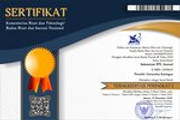THE IMPACT OF PEER RESPONSE ON EFL LEARNERS’ WRITING DESCRIPTIVE TEXT
Abstract
The aim of this study is to find out whether or not there is a significant difference between students who are taught by using peer response technique and those who are not taught by using peer response technique in writing descriptive text. This study used quantitative research method with quasi-experimental design. The population of this research was the 175 students of tenth grade at SMK Bandung Barat, while the sample was 26 students of X 2 Farmasi and X TLM. Writing test was used as the instrument of the study. The data were collected from the result of pretest and posttest. Then, the gain of both classes was analyzed by using t-test in SPSS. The result of the study showed that the mean of gain score in experimental class was 0.38 and the mean of gain score of students in control class was 0.22. It meant that there was difference in improvement between both classes. The hypotheses testing showed that sig. 2 tailed values (p) was 0.000 while alpha α was 0.05. In other words, p < α. It indicated that H0 was rejected. Therefore, it can be concluded that there is a significant difference between students who are taught by using peer response technique and those who are not taught by using peer response technique in writing descriptive text.
Keywords: descriptive text; peer response technique; teaching; writing.Full Text:
PDFReferences
Anderson, M., & Anderson, K. (1998). Text types in English 3. Australia: Macmillan Education Australia Pty Ltd.
Anggun, S. K. (2016). An analysis of descriptive text in english textbook using transitivity system (A case study of reading passages). Journal of English and Education, 4(1), 147–158.
Barron, R. (2009). What I wish I had known about peer response groups but didn’t. The English Journal, 80(5), 34.
Brown, H. D. (2001). Teaching by principles: An interactive approach to language pedagogy. San Fransisco: Longman.
Genneti, C. (2014). How languages work: An introduction to language and linguistics. New York: Cambridge University Press.
Gerot, L., & Wignell, P. (1995). Making Sense of functional grammar. Australia: Gerd Stabler.
Hansen, J. G., & Liu, J. (2005). Guiding principles for effective peer response. ELT Journal, 59(1), 31–38. doi: 10.1093/elt/cci004.
Hoogeveen, M. (2012). Writing with peer response using genre knowledge; classroom intervention study. University of Twente. doi: 10.3990/1.9789036534895.
Knapp, P., & Watkins, M. (2005). Genre, text, grammar: Technologies for teaching and assessing writing. Sidney: University of New South Wales Press Ltd.
Nunan, D. (2003). Practical English language teaching. Singapore: McGraw-Hill.
Ramadia, G., Yandri, & Tanjung, F. (2014). Teaching writing paragraphs using e-peer response technique (through blog) at university. Abstract of Undergraduate, Faculty of Education, Bung Hatta University, 3(6), 162–165.
Richards, J. C., & Renandya, W. A. (2002). Methodology in language teaching. New York: Cambridge University Press.
Rizqiya, R. S., Pamungkas, M. Y., & Inayah, R. (2017). The use of P.O.W.E.R. learning as a learning strategy to improve students writing competency. OKARA: Jurnal Bahasa Dan Sastra, 11(2), 253–262.
Rozuna. (2012). The effect of using peer response groups technique toward writing ability in narrative text at the second year students of islamic senior high school of Darel Hikmah Pekanbaru. State Islamic University of Sultan Syarif Kasim Riau.
Situmeang. (2016). The effect of peer response technique on students’ achievement in writing descriptive text. Universitas Negeri Medan.
Spear, K. (1988). Sharing writing. Porstmouth: Boynton/Cook Publishers.
Tang, G. M., & Tithecott, J. (1999). Peer response in ESL writing. TESL Canada Journal, 16(2), 20–38.
Tiwari, D. (2005). Encyclopedia of modern methods of teaching 7. New Delhi: Cressent.
Torwong, P. (2003). Peer response technique : A proposed model for EFL writing. Suranaree University of Technology.
Westwood, P. (2008). What teachers need to know about reading and writing difficulties. Australia: ACER Press.
DOI: https://doi.org/10.25134/ieflj.v5i1.1611
Refbacks
- There are currently no refbacks.

This work is licensed under a Creative Commons Attribution-ShareAlike 4.0 International License.

